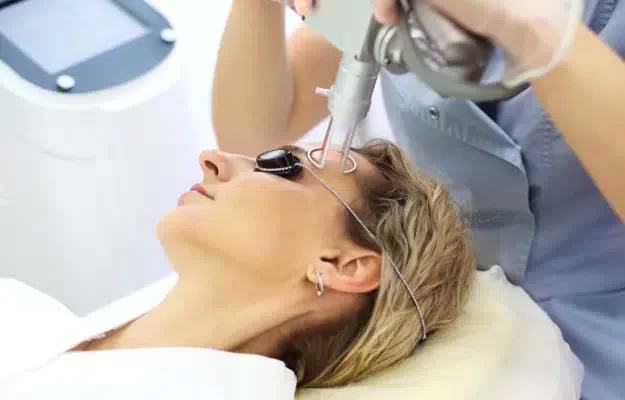Hyperpigmentation and Melasma are two everyday skin issues that result in changes in skin colour, but it’s important to understand that they are not the same thing.
Let’s begin with hyperpigmentation. Essentially, this term is a catch-all label for any kind of skin problem that leads to parts of your skin getting darker. This can be triggered by a variety of factors. For example, being out in the sun a lot might damage your skin, causing it to darken. Similarly, having severe acne or skin inflammation can sometimes leave your skin with dark marks once it has healed.
Hyperpigmentation can manifest itself in several ways. You might see small speckles on your skin that look like freckles. Or, you might notice larger dark spots, which are often referred to as sun spots. In some instances, hyperpigmentation can result in much larger patches of skin becoming discoloured. The seriousness of the condition can differ greatly – for some people, it might only affect a few tiny parts of their face, while others might find that larger areas of their skin are affected.
What is melasma?
Melasma is a widespread skin pigmentation disorder, characterised by brown or greyish patches that appear on the face. It’s a condition that predominantly affects women more than men.
The areas of the face most often impacted by melasma include the upper lip, cheeks, forehead, and the bridge of the nose. However, it’s not exclusively a facial condition – melasma can also show up on other parts of the body that get a lot of sun exposure, such as the shoulders, neck, and forearms.
The patches are usually symmetrical, with matching marks appearing on both sides of the face. It’s important to note that while melasma may cause cosmetic concerns, it’s a harmless condition. Hormonal changes, such as pregnancy or birth control, and exposure to the sun primarily cause it.
What causes Melasma?
Melasma is a complex condition with several factors contributing to its onset. Some of the main causes include:
- Hormonal Changes: Hormonal fluctuations are one of the leading causes of melasma, particularly in women. Pregnancy, use of birth control pills, or hormone replacement therapy can lead to the onset of melasma. This is why the condition is often referred to as the “mask of pregnancy.”
- Sun Exposure: Ultraviolet (UV) light from the sun can trigger the production of melanin, leading to the dark patches characteristic of melasma. This is why the condition can worsen in the summer and improve in the winter months.
- Genetics: If family members have had melasma, you are more likely to develop the condition yourself.
- Skin Type: Individuals with darker skin types are more prone to melasma because their skin produces more melanin.
- Certain Medications: Some drugs, including certain types of hormone treatments, can trigger melasma.
Despite these known factors, the exact causes of melasma are not fully understood. It’s also worth noting that melasma is a benign condition, meaning it does not pose any serious health risks, though it can cause significant emotional distress due to its effect on appearance.
Do I have melasma?
If you suspect that you have melasma, you should indeed seek the advice of a medical professional at Centre for Surgery. This condition often presents itself as brown or grey patches on the skin, typically on the face. It’s commonly seen on the cheeks, forehead, upper lip, and the bridge of the nose, but it can also appear on other parts of the body that get a lot of sun exposure, like the neck and forearms.
However, while these signs might suggest melasma, they are not definitive. Many other skin conditions can cause similar discolouration, so it’s important to get a correct diagnosis. This often involves a clinical examination, and in some cases, your doctor or dermatologist might use a device called a Wood’s lamp to examine your skin more closely. In certain instances, a small skin biopsy might be necessary to rule out other conditions and confirm the diagnosis.
So, if you’ve noticed uneven, dark patches appearing on your skin and suspect that you might have melasma, the best course of action is to schedule an appointment with at our Baker Street clinic. We will be able to properly diagnose the condition and guide you towards the most appropriate treatment options.
How is melasma treated?
In several instances, especially when melasma is triggered by hormonal fluctuations due to contraception pills or pregnancy, it may gradually disappear after childbirth or once you cease using birth control.
However, if the melasma doesn’t fade, various treatments are available to assist in reducing or eliminating the patches.
At our Baker Street clinic, we provide various treatments for melasma and hyperpigmentation, each tailored to meet the individual’s unique skin requirements. After an in-depth skin consultation, our specialists may recommend the following:
Obagi Nu-Derm System: A complete skincare routine that uses prescription-grade products designed to tackle skin discolouration. This system has been shown to be notably effective in reducing the appearance of melasma, resulting in a healthier, more even skin tone.
Chemical Peels: We offer a wide array of skin peel treatments that can be customised to cater to your skin type and address any skin concerns, including melasma. These treatments function by aiding the removal of skin cells containing excess pigment, resulting in a brighter, more uniform skin tone.
Fotona Laser Resurfacing: Laser resurfacing treatment has been successful in treating melasma. However, due to the risk of potentially exacerbating the condition, it is not usually the first treatment choice. An extensive skin assessment needs to be carried out before considering laser treatment for melasma.
How to avoid Melasma and Hyperpigmentation
Avoiding melasma and hyperpigmentation can be a challenge, especially if you’re predisposed due to genetic or hormonal factors. However, there are several things you can do to minimise your risk:
- Sun Protection: This is the most crucial step in preventing melasma and hyperpigmentation. The sun’s ultraviolet (UV) rays stimulate melanocytes, which are the cells that produce melanin – the pigment that gives your skin its colour. Increased melanin production can lead to hyperpigmentation. Always use broad-spectrum sunscreen with an SPF of 30 or higher, even on cloudy days, and reapply it every two hours if you’re out in the sun. It’s also beneficial to wear protective clothing, such as wide-brimmed hats and long sleeves, and try to stay in the shade during peak sun hours (10 a.m. to 4 p.m.).
- Avoid Hormonal Triggers: Hormonal fluctuations, such as those that occur during pregnancy or with the use of birth control pills, can trigger melasma. If you’re prone to hyperpigmentation, discuss alternative contraception methods with your doctor.
- Skin Care Products: Use gentle skin care products. Avoid any product that stings or burns your skin, as these can irritate your skin and worsen melasma.
- Healthy Lifestyle: A balanced diet rich in antioxidants can help prevent damage that leads to premature ageing and hyperpigmentation. Likewise, regular exercise improves circulation and helps to keep your skin healthy.
- Consult a Skin Specialist: If you’re prone to hyperpigmentation or melasma, consult a skin specialist. They can guide you on the best preventive measures based on your skin type and risk factors.
- Avoid Waxing: Waxing may cause skin inflammation which can lead to a breakout of melasma or hyperpigmentation, especially in individuals who are prone to these conditions.
Hyperpigmentation melasma treatment at Centre for Surgery
At Centre for Surgery, we’re committed to helping our clients achieve their ideal appearance and enjoy healthier, more vibrant skin. We understand the impact that skin conditions like hyperpigmentation and melasma can have on your self-esteem, and we’re here to offer solutions that work.
Our team is composed of highly skilled skin experts with extensive training and experience in diagnosing and treating a wide range of skin conditions. We pride ourselves on our personalised approach. We understand that every client’s skin is unique, so we tailor our treatments to suit your individual needs.
When it comes to hyperpigmentation and melasma, we offer several effective treatment options, including Obagi Nu-Derm System, chemical peels, and laser resurfacing. All of these treatments aim to reduce the appearance of these conditions, resulting in a more even skin tone and improve overall skin appearance.
With the Obagi Nu-Derm System, we offer a comprehensive skincare regimen using prescription-strength products that target skin discolouration. For a more hands-on approach, our chemical peels work by removing the skin cells containing excess pigment.
We also offer Fotona Laser Resurfacing, although it requires a thorough skin assessment before treatment. We use it as a reserve treatment when other approaches aren’t as effective.
In addition to providing treatments, we also offer advice on how to maintain your skin post-treatment and how to prevent the recurrence of hyperpigmentation and melasma.
Centre for Surgery is located at Baker Street, and our friendly team is ready to assist you. To learn more about our hyperpigmentation and melasma treatments, please call 0207 993 4849 or use our online contact form. We look forward to helping you on your journey to clearer, brighter skin.










